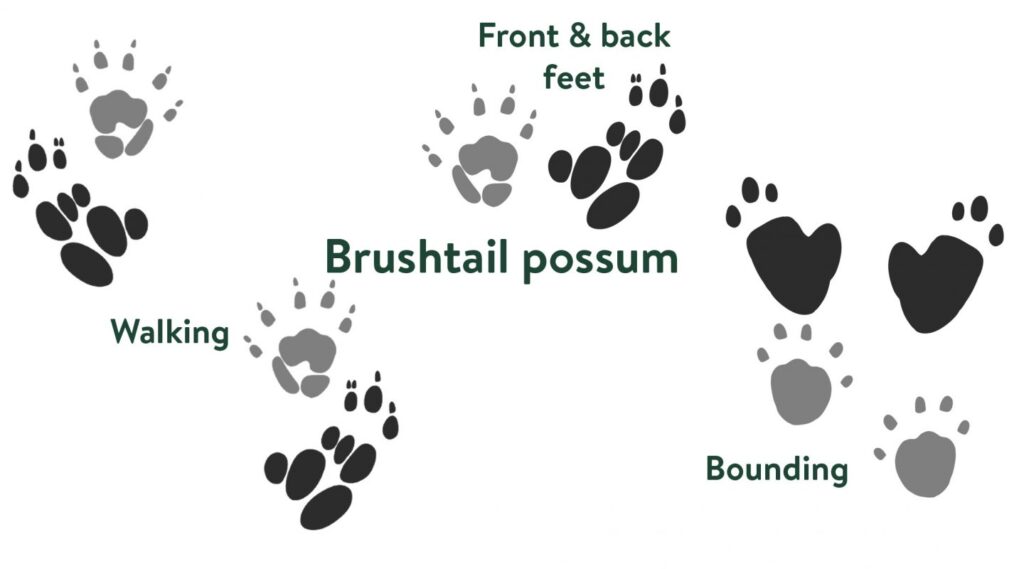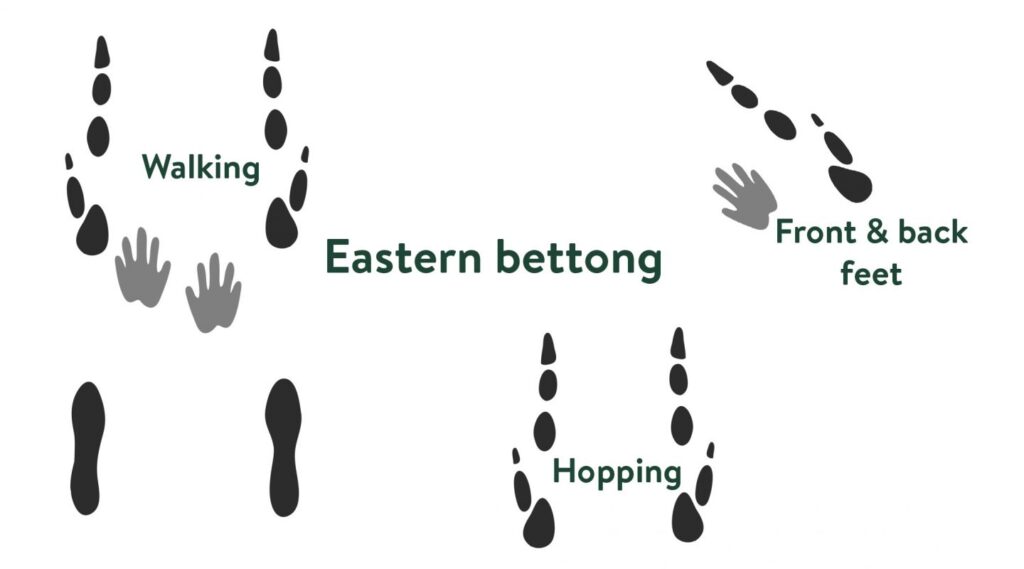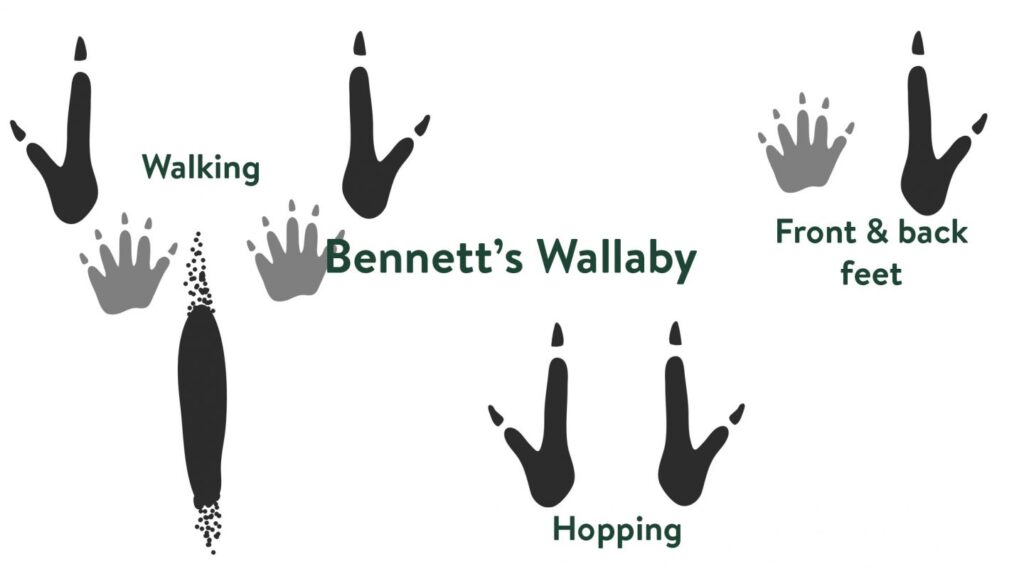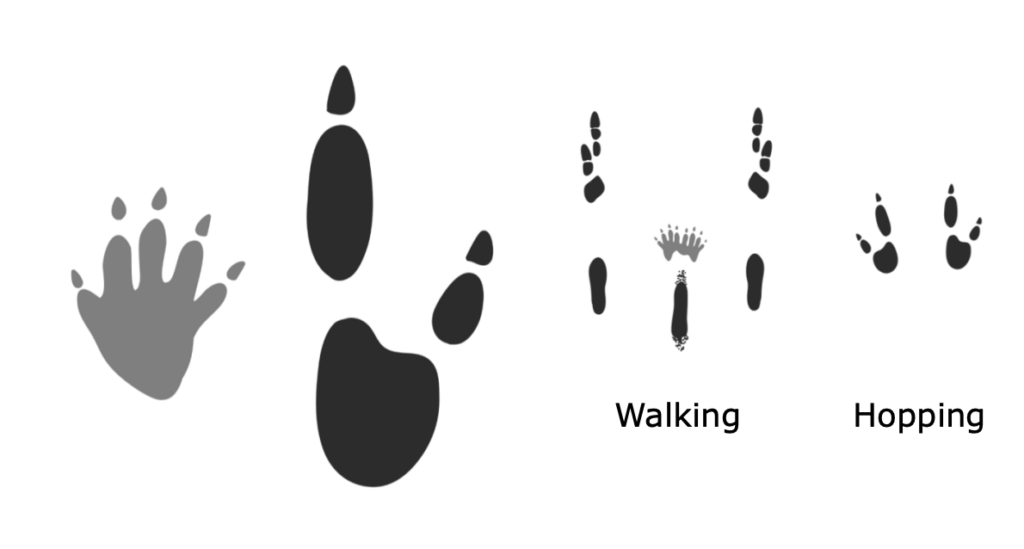🐾 Struggling to identify an animal recorded during your WildTracker survey? Don’t worry, it happens to the best of us. This guide may just have the information you need to classify your quadruped.
Correctly identifying wildlife from camera images can be challenging but, as with most things, becomes easier with practice. Over time and with some willing wildlife posers, you’ll learn how to use cues that go beyond the physical shape, colour and size of an animal to recognise the species in question. What posture is the animal in? Is it grooming, grazing or scent-marking? Does its fur look wet? Is it one individual of a larger group? All of these questions can help narrow down which creature you may be looking at.
Unless you have a white-flash camera, most images you collect will be taken at night using infra-red. This can make identification particularly tricky because animals will appear as various shades of grey. Shading can be useful, though. For example, a distinguishing feature of the Bennett’s wallaby is a dark stripe down its face and black paws. Still images taken at night can also make it difficult to judge an animal’s size; a pademelon close up could be confused for a Bennett’s wallaby (if we didn’t have those shades of grey 😉). The size of an animal is best judged by comparing it to photos of other species taken in the same survey, from the same location.
Something that us humans have over artificial intelligence (so far…) is the ability to take into context the images preceding and following an observation record. If in a burst of 3-photos, Photo 1 is of an adorable eastern bettong, Photo 2 is a super blurry flash of grey, and Photo 3 is of a bettong still being adorable, then it is quite likely that number 2 was the same bettong mid-bounce. Use your judgement in how you assign a tag in WildTracker.
THERE WILL BE PHOTOS THAT ARE UNIDENTIFIABLE.
Even the most experienced camera-trapper can be stumped by a blurry photo or an unhelpful angle of a fluffy-bum. Animals may zoom past the camera causing a ghostly shadow or be so far away that only their eye-shine is visible. If the following guide fails to help you identify the species in your image, please assign the ‘unknown’ tag in WildTracker. Now and then, ecologists at the Tasmanian Land Conservancy will peruse all of the unknowns and use them to further develop this guide.
NAMING CONVENTIONS
In this guide, we may present several names for a single species. First, the common name will be given for the animal as it is known in Tasmania (as opposed to mainland Australia). Second, the Latin or scientific name for the species is given in italics. Then, with thanks to the Tasmanian Aboriginal Centre, we provide animal names in palawa kani, the language of the Tasmanian Aborigines.
- Bennett’s wallaby
- Bare-nosed wombat
- Common brushtail possum
- Eastern barred bandicoot
- Eastern bettong
- Eastern ringtail possum
- Eastern quoll
- European rabbit
- European (brown) hare
- Fallow deer
- Feral cat
- Forester kangaroo
- Long-nosed potoroo
- Rakali – Water rat
- Short-beaked echidna
- Southern brown bandicoot
- Spotted-tailed quoll
- Tasmanian devil
- Tasmanian pademelon
- Antechinus coming soon
- Platypus coming soon
- Pygmy possums coming soon
- Rodents (other) coming soon
BENNETT’S WALLABY
Macropus rufogriseus | payathanima (pie yah dthah nee mah) – wallaby
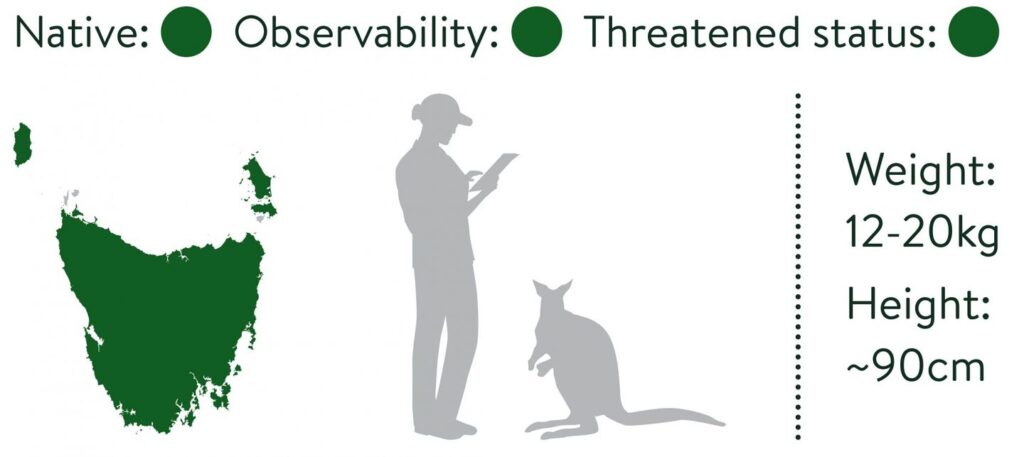
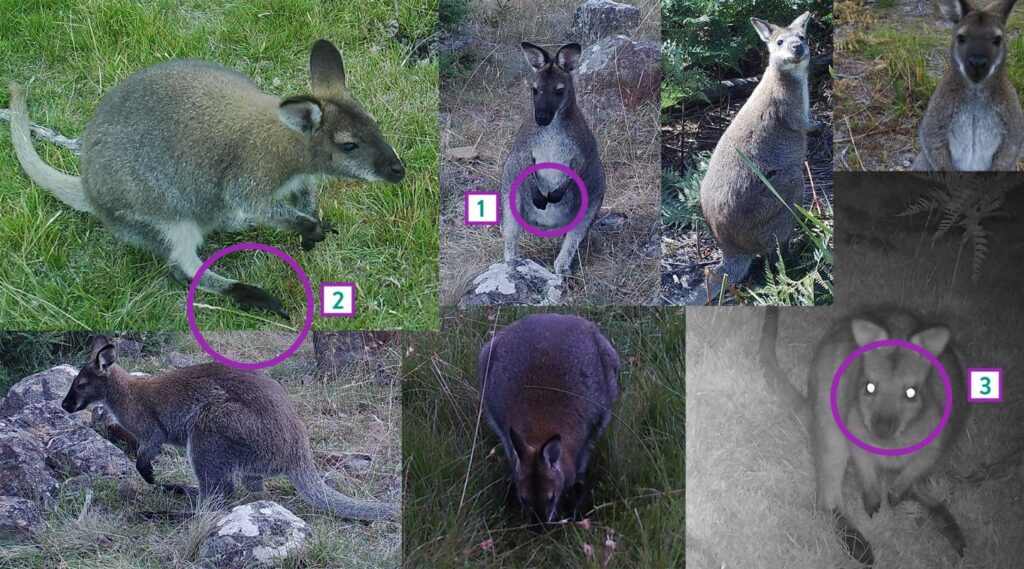
Key identifying features
Reddish coat, particularly around the back of the neck. Known elsewhere as the red-necked wallaby. Dark forepaws (1), hindfeet (2) and nose (3). Dark stripe down centre of the face with white markings on the side. Often black rim or tips on the ears. Coat appears to vary in colour across the body. Grey-white underbelly. Long robust tail almost the same length as the body. Eats browse and grass. Often recorded socialising.
Similar species
Tasmanian pademelon – usually smaller body size; rounder; shorter and less defined hind legs, more uniform in colour; tail is shorter than body.
Forester kangaroo – larger and more muscular body; larger ears; lacks black markings on nose and ears; absence of white markings on face; coat is less rufous and more grey.
FORESTER KANGAROO
Macropus giganteus | tara (tah rah) – kangaroo
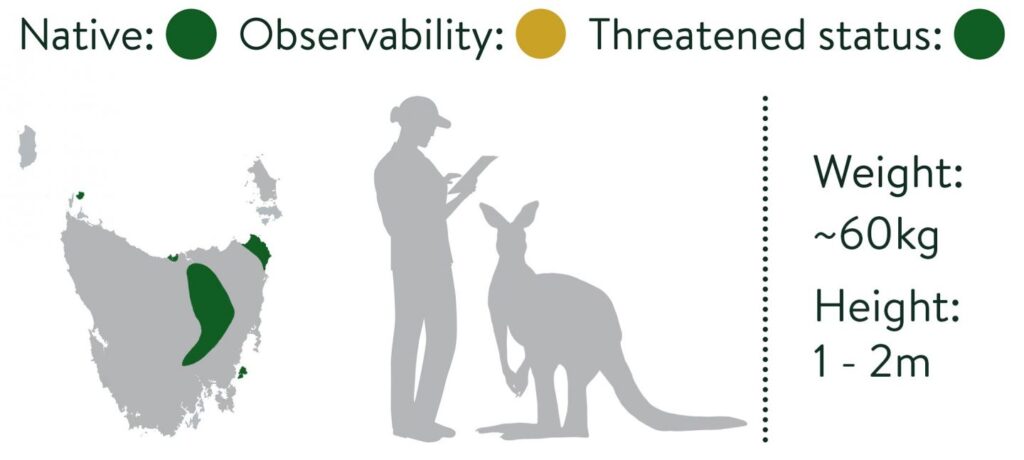
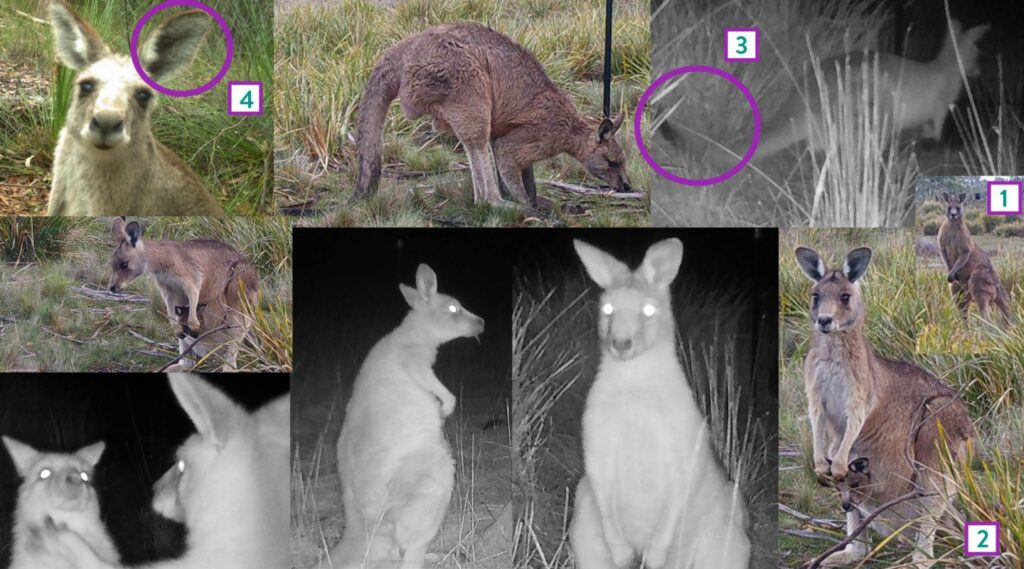
Key identifying features
Largest native land mammal in Tasmania, second largest in Australia. Known as the Eastern grey kangaroo elsewhere in Australia. Males (1) are much larger and more muscular than females (2) but both sexes have a stockier build than other Tasmanian macropods. Thick tail, often darkening in colour along its length to a black tip (3). Large ears that sit high on the head (4) and a broad muzzle. Light brown-grey coat, pale grey underbelly. Females are greyer than males. Will graze in open environments.
Similar species
Bennett’s wallaby – smaller body and ears; tail is not as thick; black markings on nose and tips of the ears; white markings down the side of the face; coat is more red-brown and less uniform in colour.
TASMANIAN PADEMELON
Thylogale billardierii
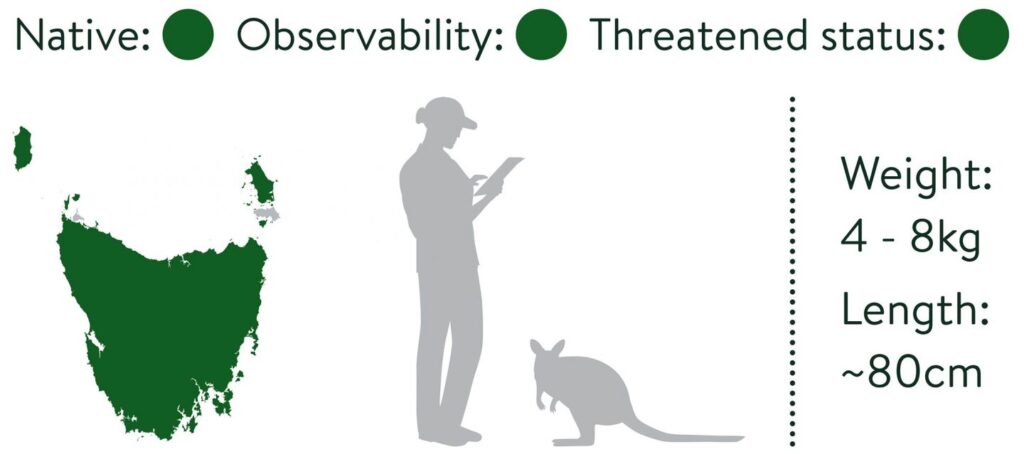
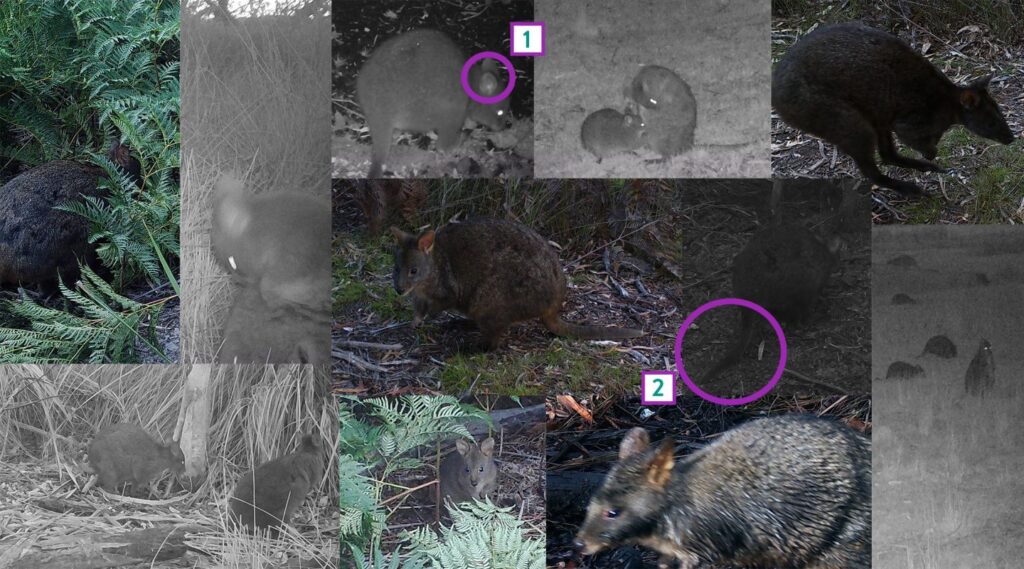
Key identifying features
Small wallaby with round body, often in an arched posture. Dark brown to rufous (red) coloured coat, more uniform than for the Bennett’s wallaby. Ears are small and round (1). Tail shorter than the body length (2). Males are larger than females. Groups may forage in open environments, but individuals typically remain close to dense vegetation cover.
Similar species
Bennett’s wallaby – usually larger body size; not as round (or cute!); longer hind legs; tail is longer than body; coat colour is not uniform with a rufous band around the neck, dark paws and stripe down face.
Eastern bettong – body is not as round; paler coat colour; much more defined and lanky hindlegs; long tail usually with white tip; smaller rounded ears; shorter muzzle.
EASTERN BETTONG
Bettongia gaimardi
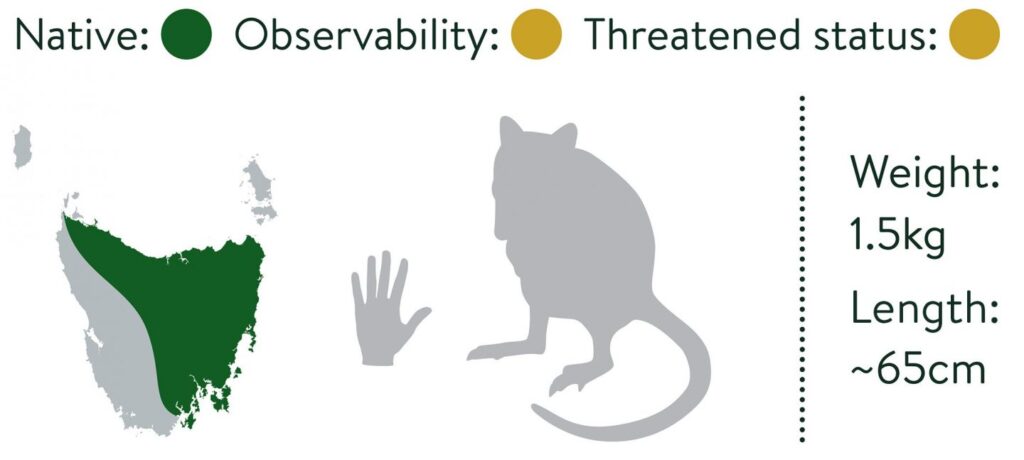
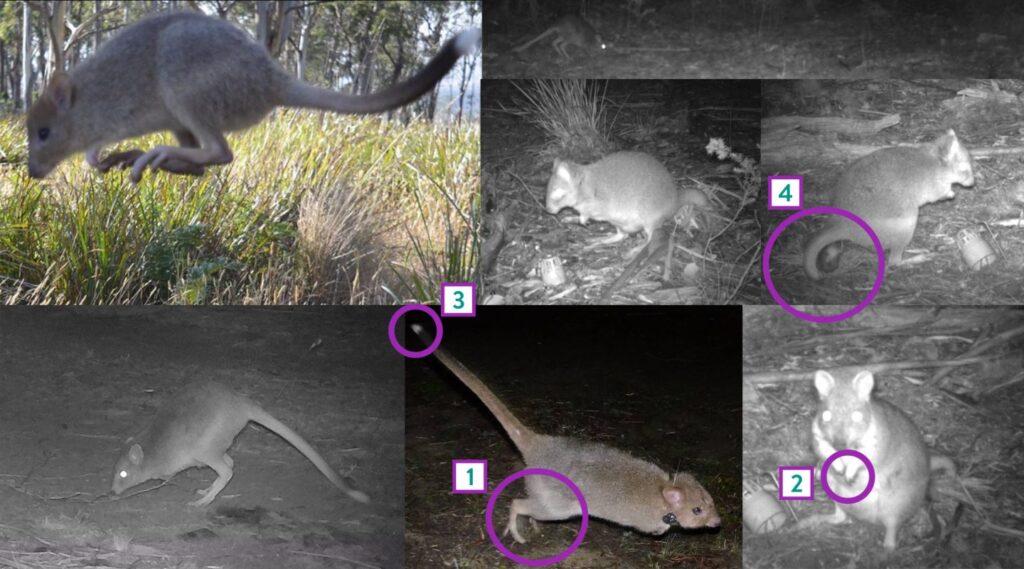
Key identifying features
Small body size, sometimes referred to as a rat kangaroo. Coat is pale grey with a white underbelly. Long hindlegs and feet for its size (1) but very short forelimbs (t-rex arms, 2). Tail is the same length as the body, often with a bushy end and white tip (3). Tail is prehensile and used to carry bunches of nesting material (grasses, 4). Small round ears and short muzzle (‘snub nose’). Fast and agile.
Similar species
Tasmanian pademelon – rounder body; darker coloured coat; shorter tail with no white tip; less defined hind legs; longer muzzle.
Long-nosed potoroo – Much shorter body that is less lanky; usually bounds on four feet rather than two; tail is sparsely furred but may also have a white tip; nose is longer and more tapering.
LONG-NOSED POTOROO
Potorous tridactylus
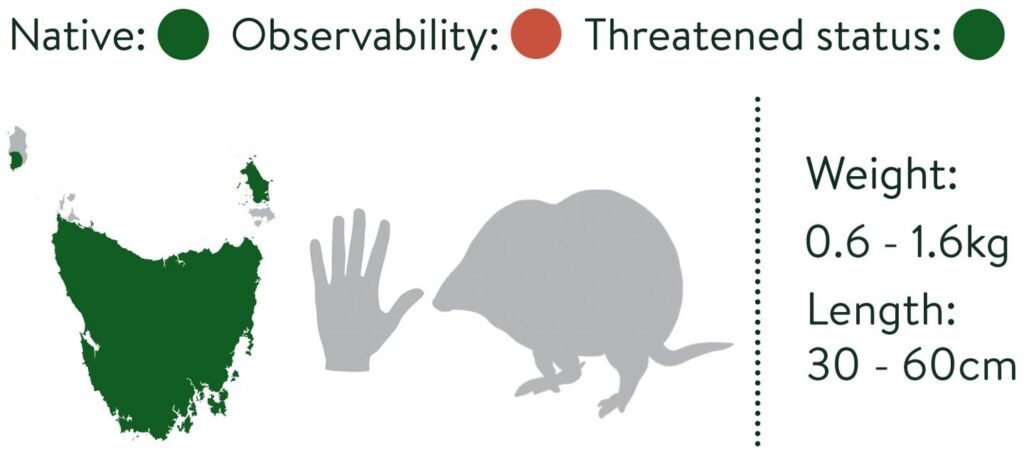
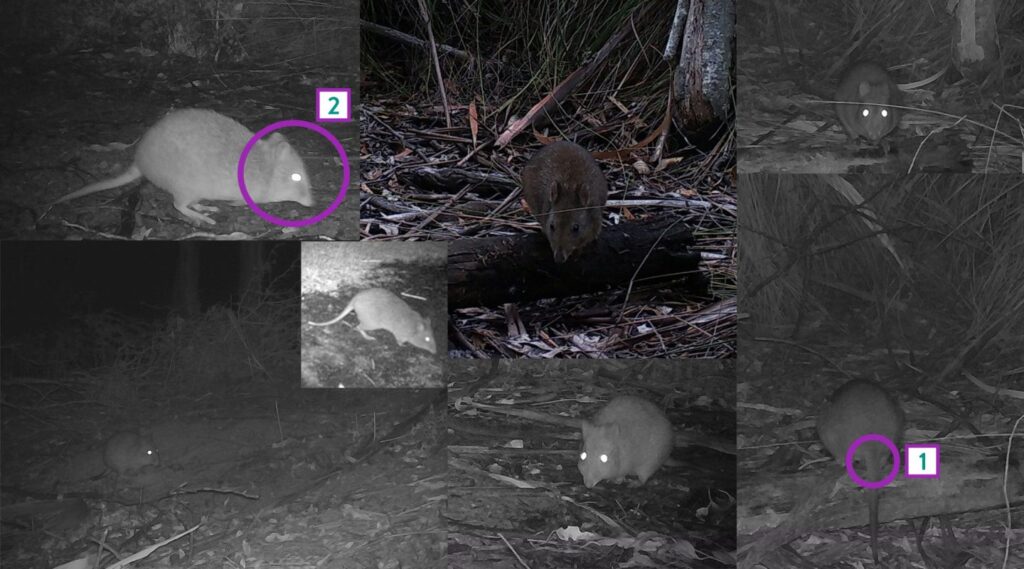
Key identifying features
Small body size. Coat colour is brown-grey with a pale underbelly. Tail is broad towards the base (1), shorter than body, sparsely furred and sometimes has a white tip. Long and tapered muzzle but not conical (2, but see here for a comparison of bettong, bandicoot and potoroo). Bare patch above the nose. Short and rounded ears. Mostly bounds on four feet.
Similar species
Eastern bettong – Taller body with longer legs; longer and thicker tail; more upright and bounds on two feet (more kangaroo like and less rat like).
Eastern barred and southern brown bandicoots – Shorter, less defined hind legs; longer and more symmetrical (conical) muzzle; shorter tail; eastern barred bandicoot has stripes.
SOUTHERN BROWN BANDICOOT
Isoodon obesulus | linira (lee nee rah) – bandicoot
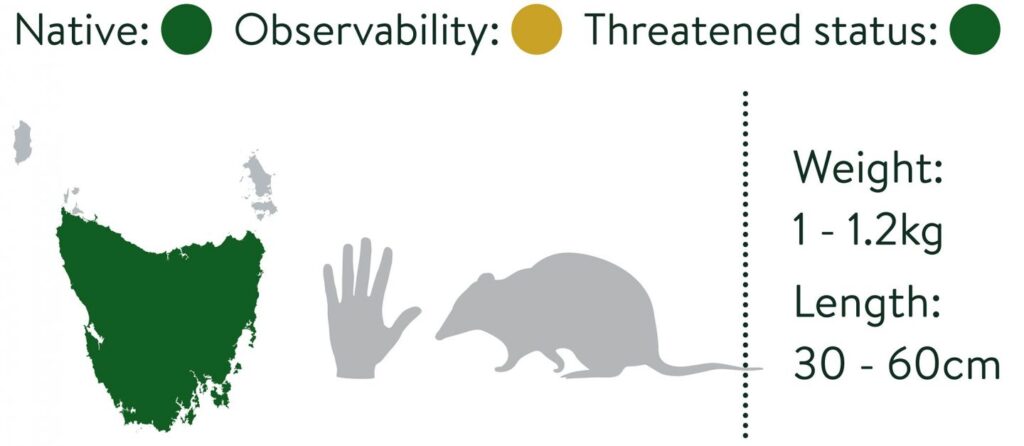
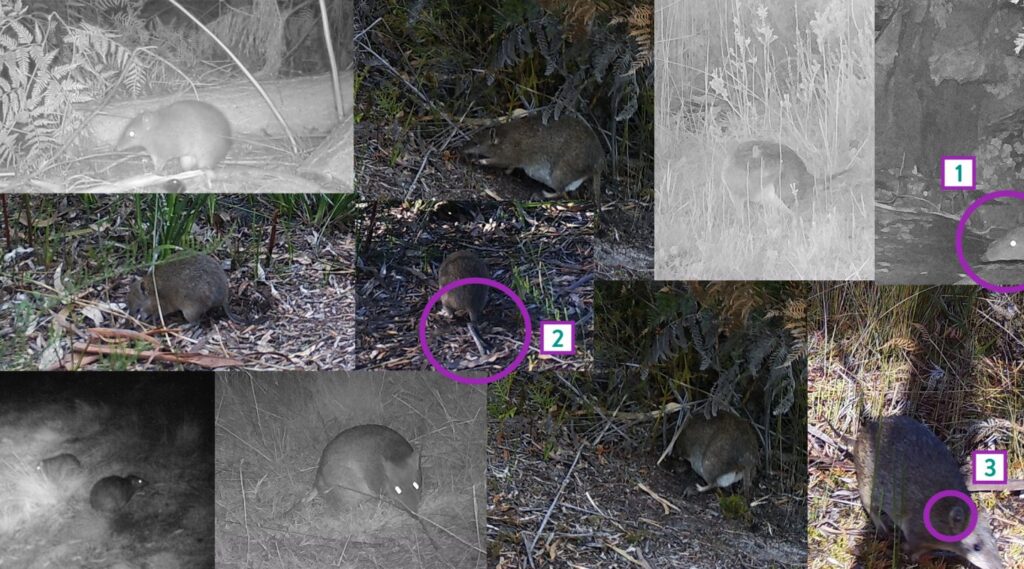
Key identifying features
Long, conical muzzle (1). Tail is thin and much shorter than the body (25-30% of head and body length, 2). Tail is a consistent width along its length. Short, rounded ears (3). Coat is grey-brown with cream-yellow underbelly and white beneath the tail. Rear-opening pouch.
Similar species
Eastern barred bandicoot – has striped coat; larger and more pointed ears; longer muzzle.
Long-nosed potoroo – Muzzle is more sculpted (not symmetrical); longer tail that may have white tip; longer rear limbs causing a more hunched stance.
EASTERN BARRED BANDICOOT
Perameles gunnii | linira (lee nee rah) – bandicoot
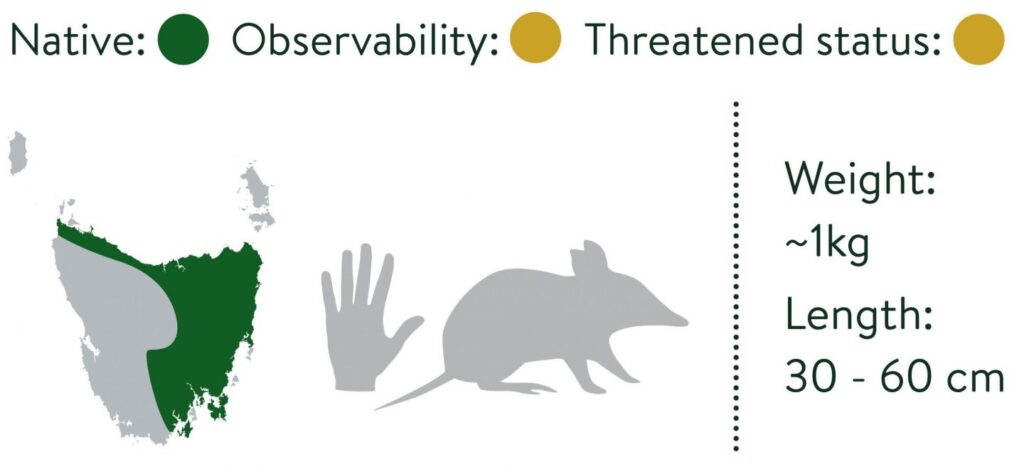
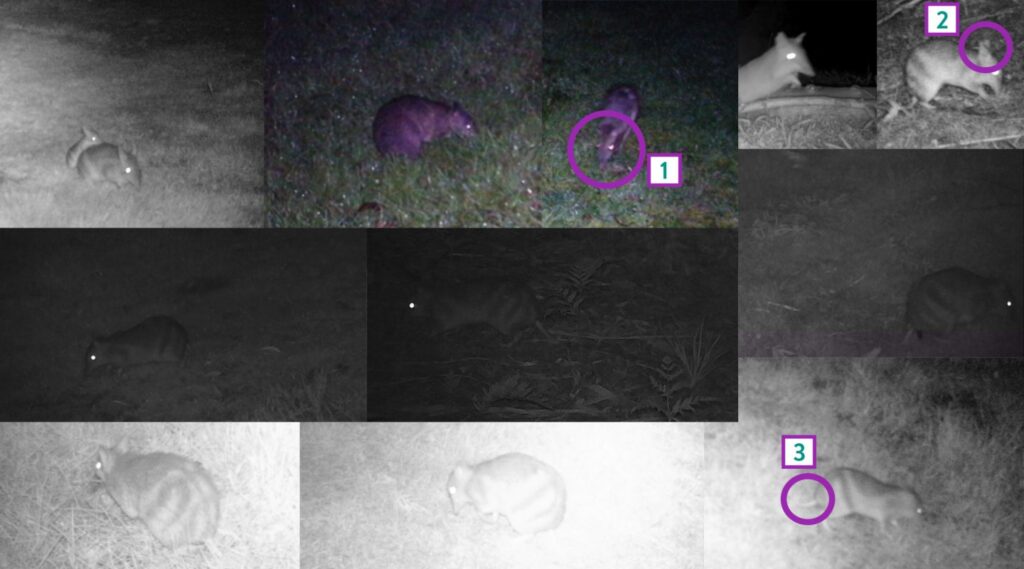
Key identifying features
Very long, conical muzzle (1). Large and pointed ears (2). Yellow-brown coat with three or four pale stripes on the hindquarters. Barring may become more obscure in older animals. Very short white tail (3). Grey-white underbelly and feet.
Similar species
Southern brown bandicoot – Lacks striped hindquarters; has smaller more rounded ears; shorter muzzle.
Long-nosed potoroo – Muzzle is more sculpted (not symmetrical); longer tail that may have white tip; longer rear limbs causing a more hunched (kangaroo-like) stance.
BARE-NOSED WOMBAT
Vombatus ursinus | prupilathina (pru pee lah dthee nah) – wombat
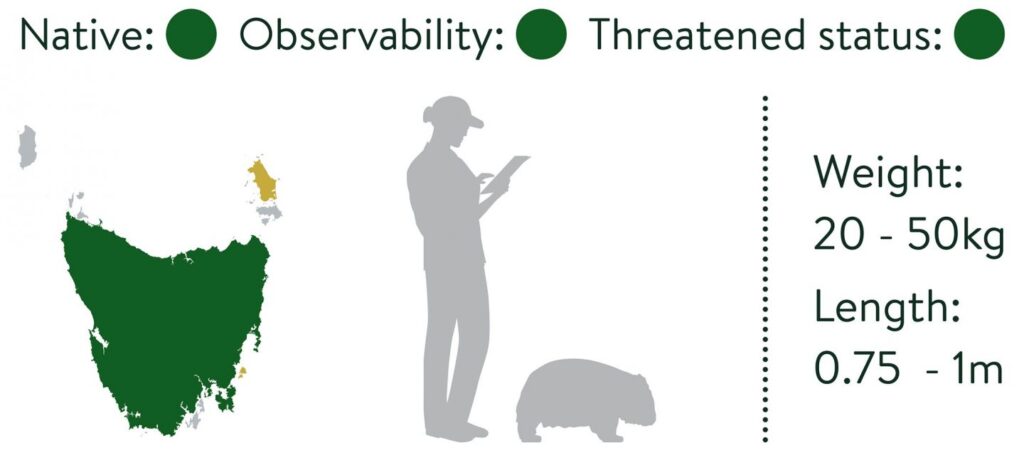
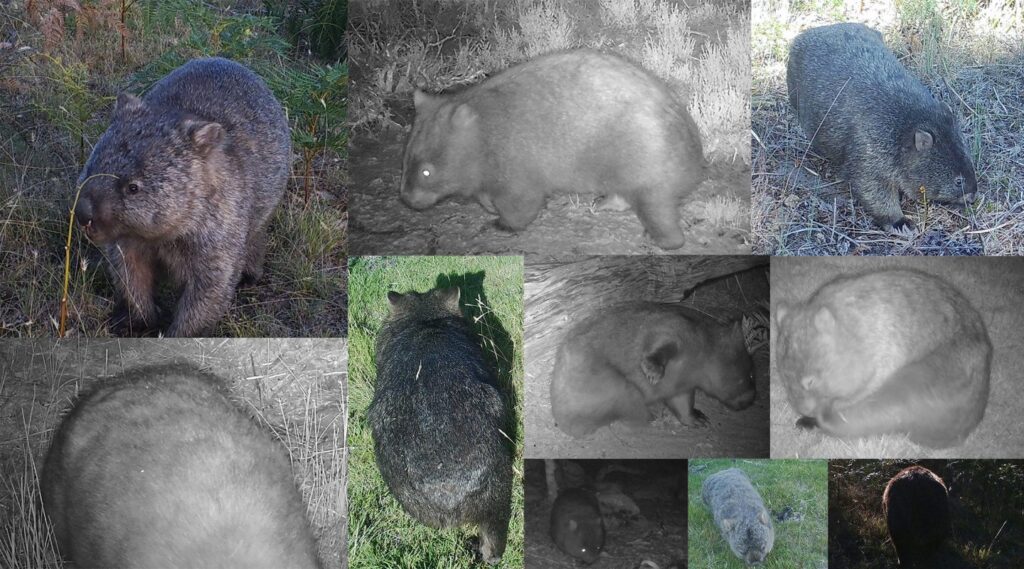
Key identifying features
Big, round, and stocky with short legs. Large ‘bare’ nose. Small eyes relative to head-size. Range of coat colours from black to blonde but most commonly a dark brown. Backward facing pouch.
Similar species
None.
TASMANIAN DEVIL
Sarcophilus harrisii | purinina (pu ree nee nah) – Tasmanian devil
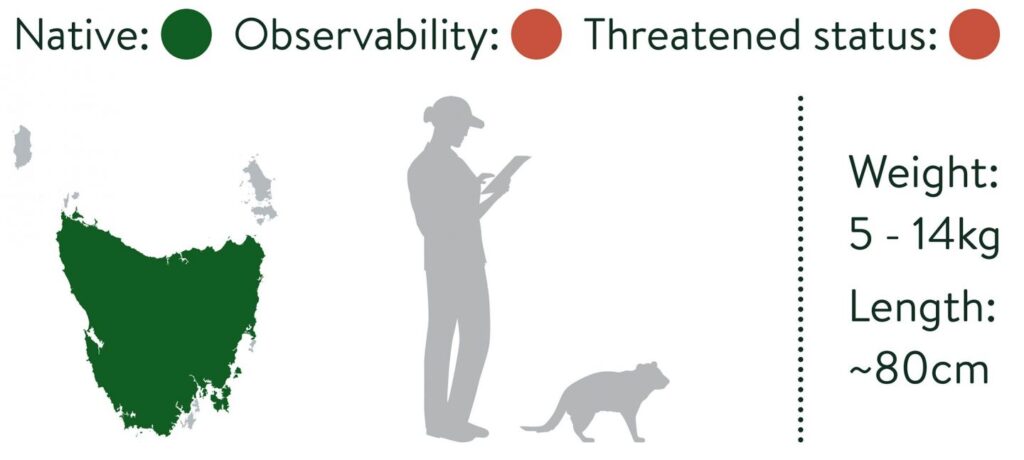
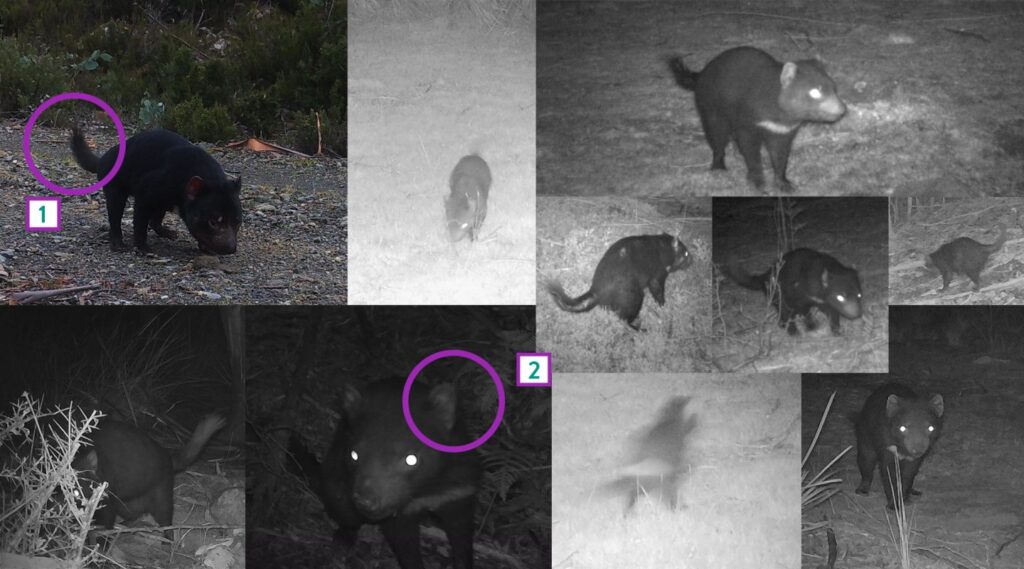
Key identifying features
Stocky and powerful build with a broad head and large black nose. Black coat, often with a white collar around the neck or other white markings on the shoulders and rump. Short muzzle that is only lightly furred with long whiskers. Tail is shorter than the body, thick, typically curved upward (1), and often appears patchily furred. Large, pink-red, pointed ears (2). Hindlegs are shorter than the front resulting in a slanted stance.
Similar species
None.
COMMON BRUSHTAIL POSSUM
Trichosurus vulpecula | timita (tee mee tah) – possum
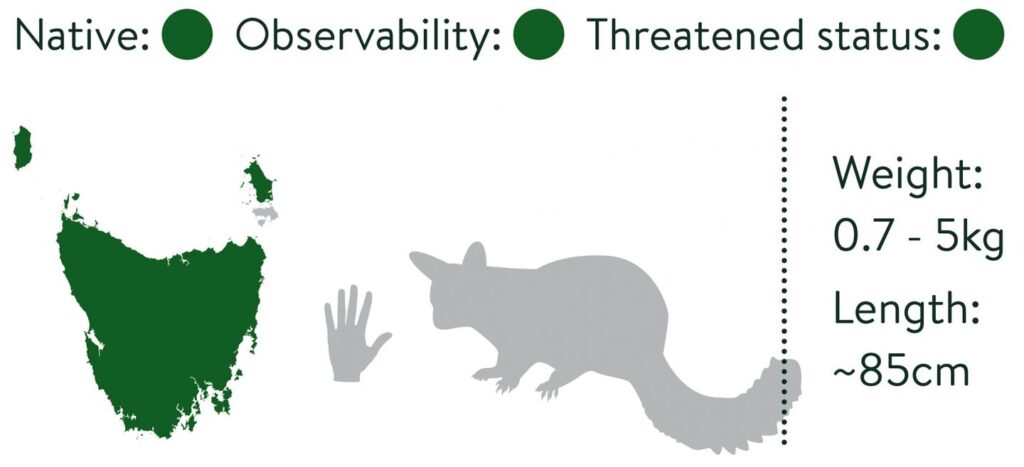
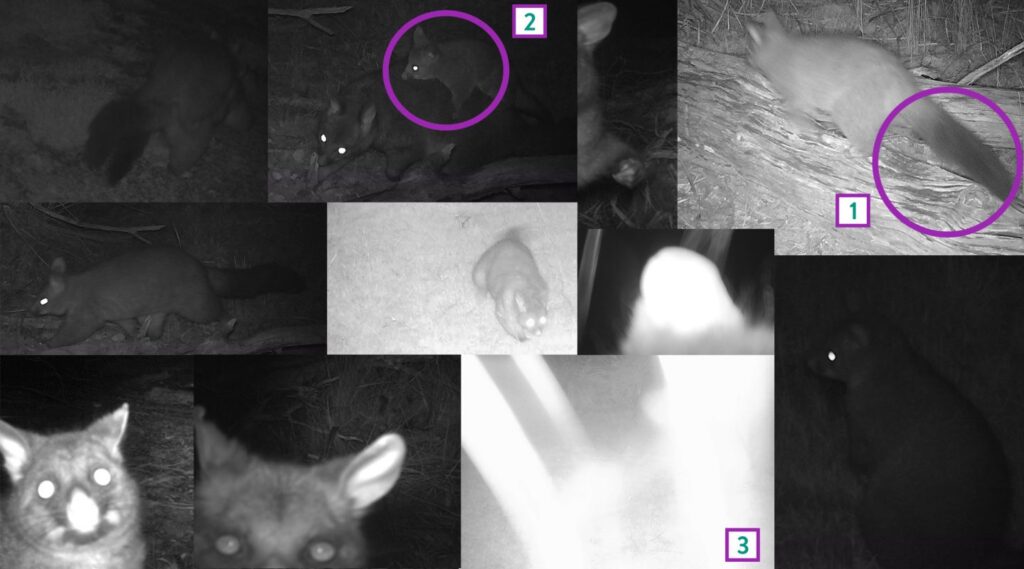
Key identifying features
Medium-sized marsupial. Thick, bushy and often darker coloured tail (1) but with a naked area underneath and at the tip. Pointed muzzle with pink nose. Large, oval ears. Coat colour can vary from light grey to black, chocolate brown, rufous or golden. Older joeys are carried on the mother’s back (2). Highly inquisitive and most common animal to interfere with the camera. Long whiskers (3) and ears often recorded in close-up.
Similar species
Eastern ringtail possum – smaller body size; tail is long, not fluffy and tapers to a white tip; shorter ears with white patches.
EASTERN RINGTAIL POSSUM
Pseudocheirus peregrinus | timita (tee mee tah) – possum
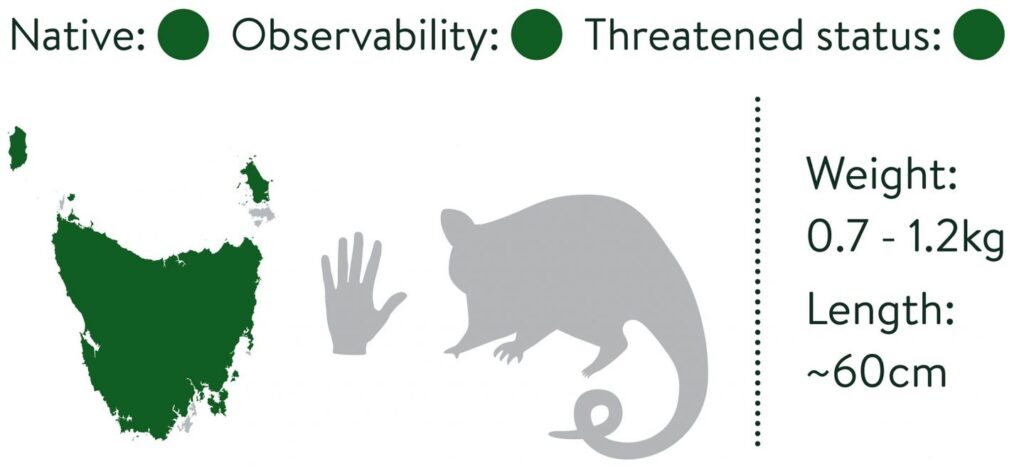
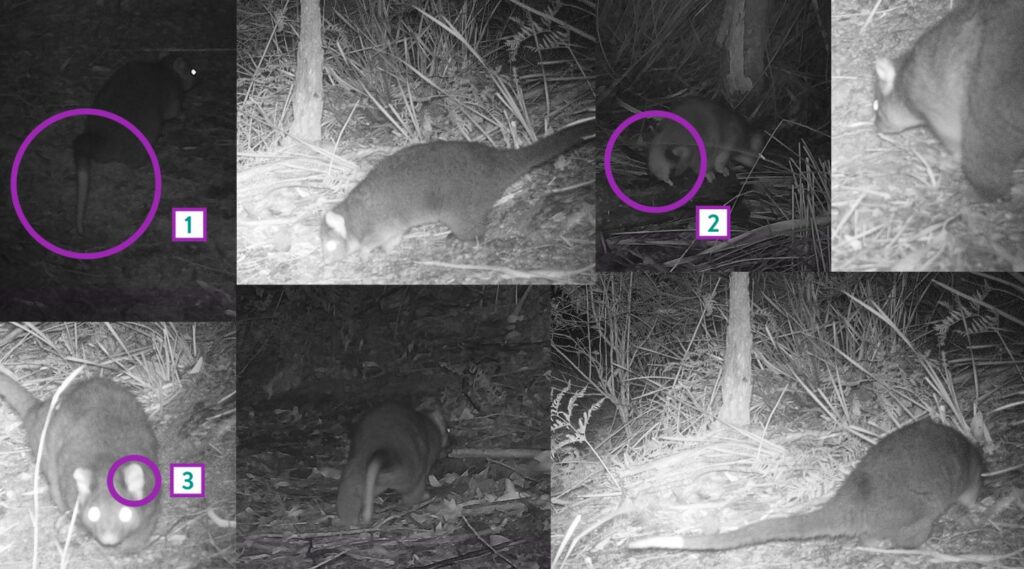
Key identifying features
Tapering prehensile tail that is naked underneath and has a distinctive white tip (1). Tail may be curled (2) or held straight when being used for balance. Grey to black coat with white underbelly. Sometimes an orange-brown shade on the legs and along the length of the tail. Large round ears (3) with white patches behind. May be recorded carrying sticks and leaves using its tail when building a nest (drey).
Similar species
Common brushtail possum – Larger body size; dark coloured fluffy tail; more pointed ears; absence of white ear patches.
EASTERN QUOLL
Dasyurus viverrinus | lapunginya (lah pu ngee nyah) – eastern quoll
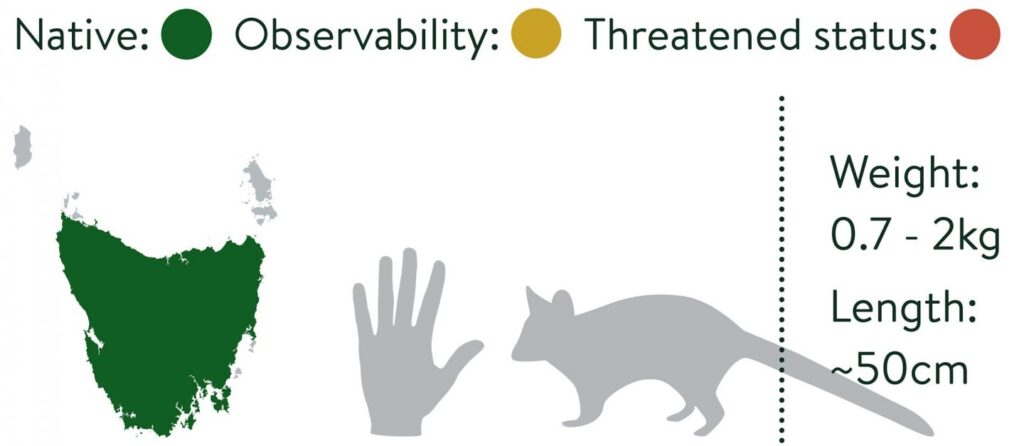
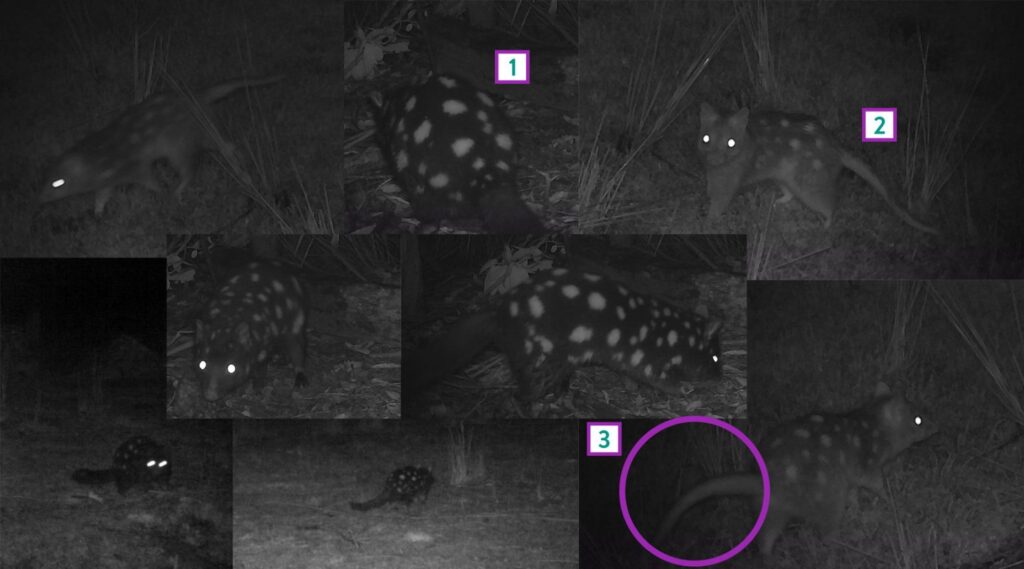
Key identifying features
Small cat-like body. Coat colour may be black (1) or fawn (tan, 2) with white spots over the body. Fawn coloured quolls have a grey-white underbelly. Tail has no spots (3), is shorter than the body and can be bushy. Large ears and eyes. Pointed muzzle with pink nose.
Similar species
Spotted-tailed quoll – larger but more sleek body; spots on the tail; smaller, rounded ears; golden-brown coat.
SPOTTED-TAILED QUOLL
Dasyurus maculatus | luwayina (lu wah yee nah) – spotted-tailed quoll
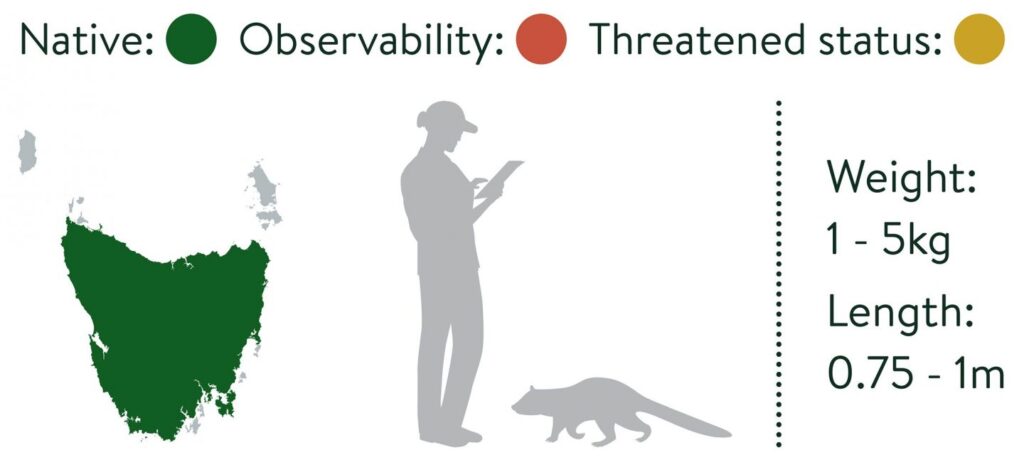
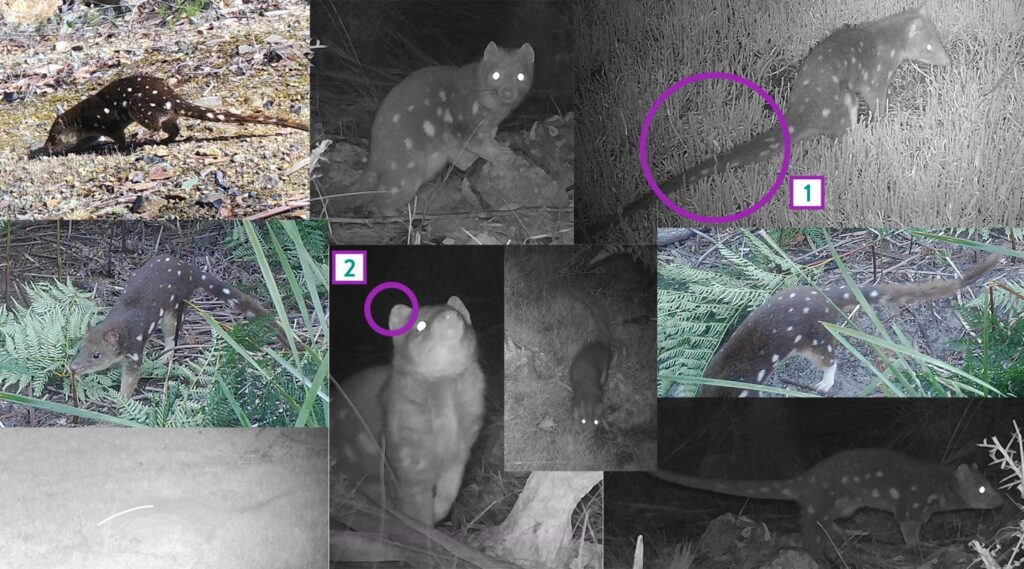
Key identifying features
Body is muscular and long. Dark red-brown to golden-brown coat with a variable number of white spots over the body, legs and along the tail (1). Pale sandy-coloured underbelly. Sometimes with white socks. Tail is thin and longer than the body. Pointed muzzle with pink nose. Small, rounded ears (2). Move in a distinctly slinky or swaggering manner.
Similar species
Eastern quoll – smaller body size; larger pointed ears; absence of spots on the tail; coat colour can be black or tan.
RAKALI, WATER RAT
Hydromys chrysogaster | linganina (leeng ah nee nah) – water rat
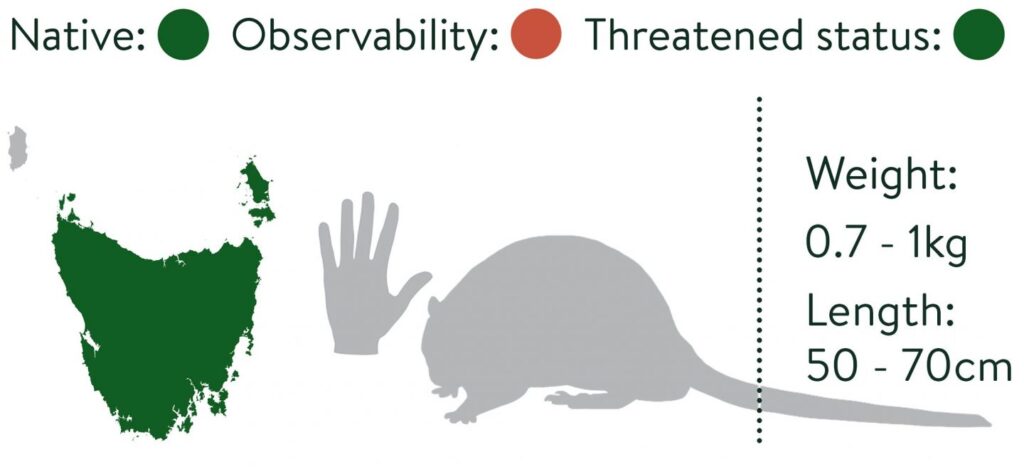
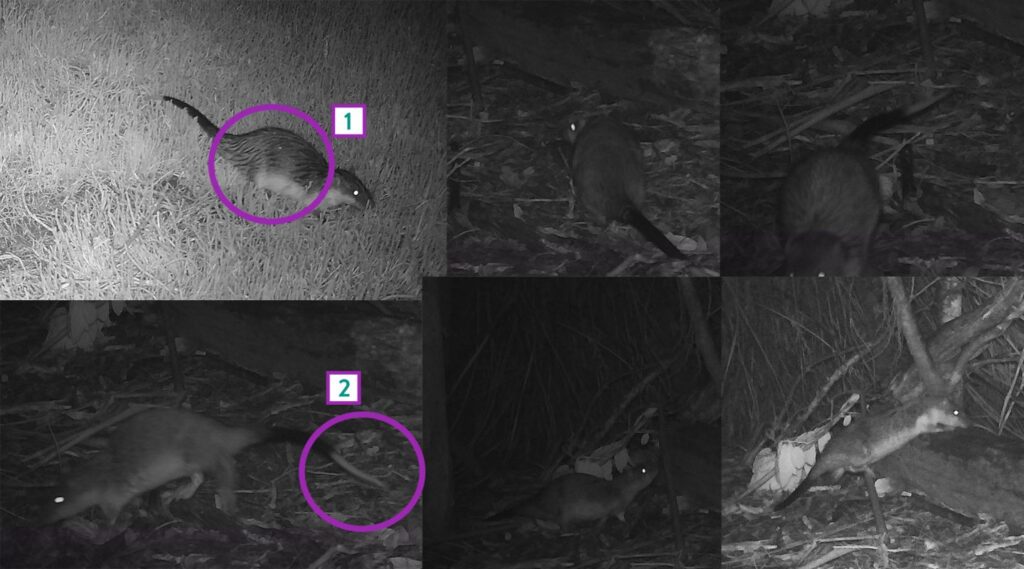
Key identifying features
Semi-aquatic – fur often looks wet (1). Sleek body with broad, webbed hindfeet. Large, flat head with small ears. Long thick tail, usually dark with a white tip (2). Black to brown coat with white or golden underbelly.
Similar species
Ringtail Possum – similar body size but more stocky; arboreal (usually in trees) with no association with water; face is less elongated but pointed.
FERAL CAT
Felis catus
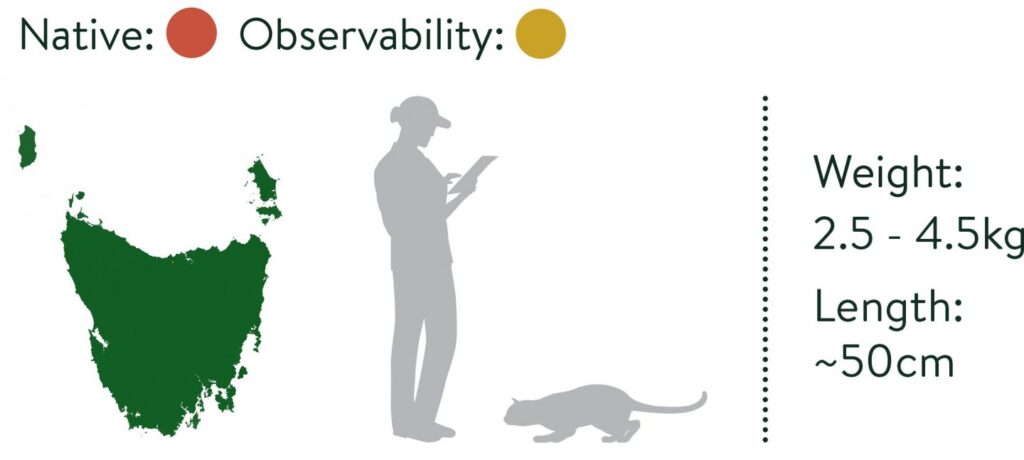
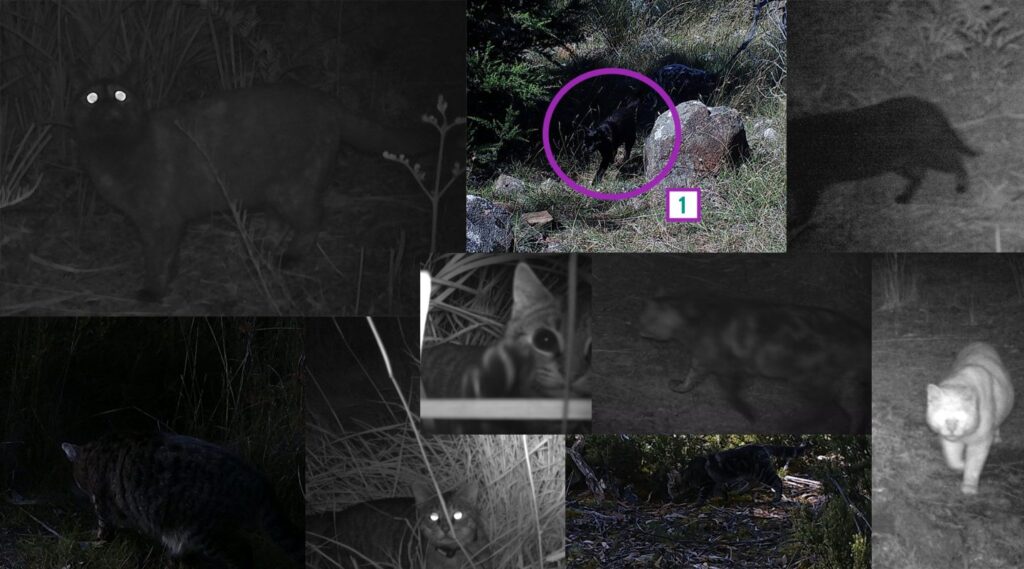
Key identifying features
Typically, a lean and muscular body. May be larger than the average domestic cat. Flat face with pointed ears. Long tail. Coat colour varies but tabby is most common in remote areas (‘wild type’). There are more striped and tortoiseshell cats in the wild but fewer black, white and ginger cats. Long-haired feral cats are rare. Some coat colours can make cats difficult to detect (1).
Similar species
None.
SHORT-BEAKED ECHIDNA
Tachyglossus aculeatus | trimanya (tree mah nyah) – echidna
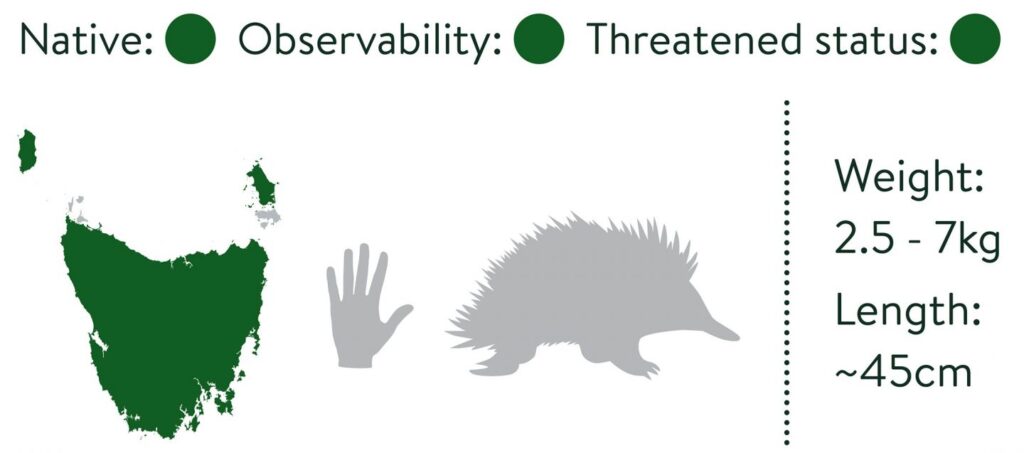
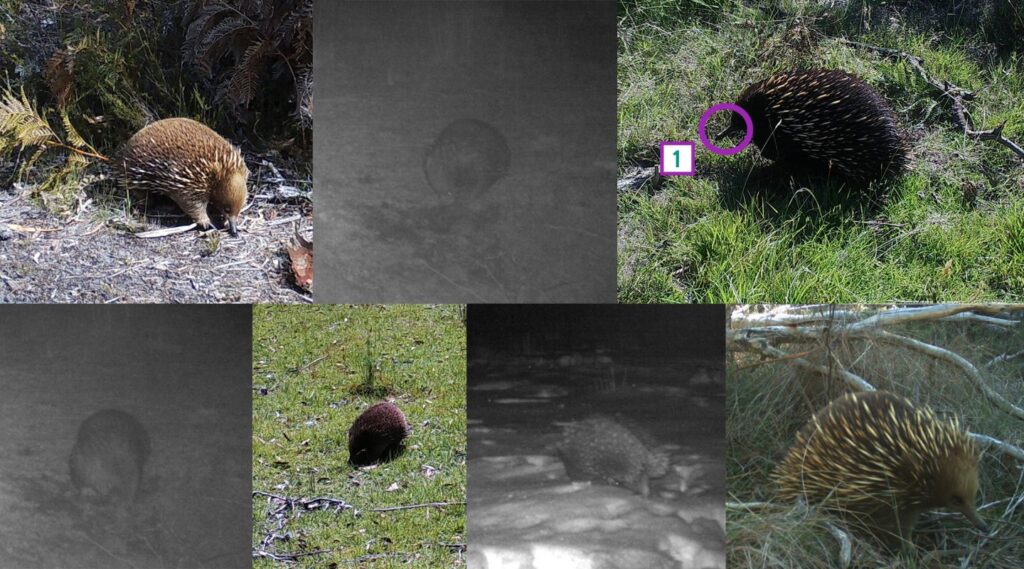
Key identifying features
Round body with sharp black-golden coloured spines. Long, strong, tubular snout (1). Small eyes. Short limbs and hind feet point ‘backward’ with long flattened claws. Fur colour varies from black to blonde. Tasmanian echidnas tend to have much more fur than mainland populations such that spines may only just protrude.
Similar species
None, but can easily be mistaken for rocks in camera images.
FALLOW DEER
Dama dama
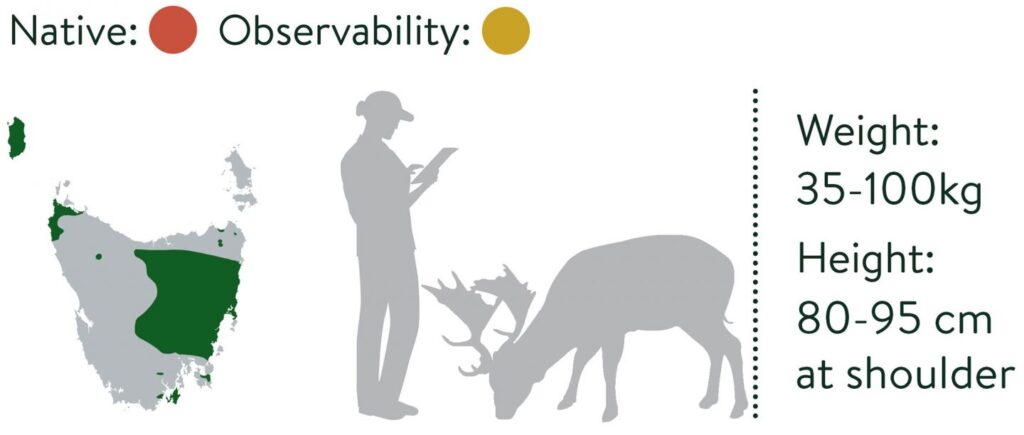
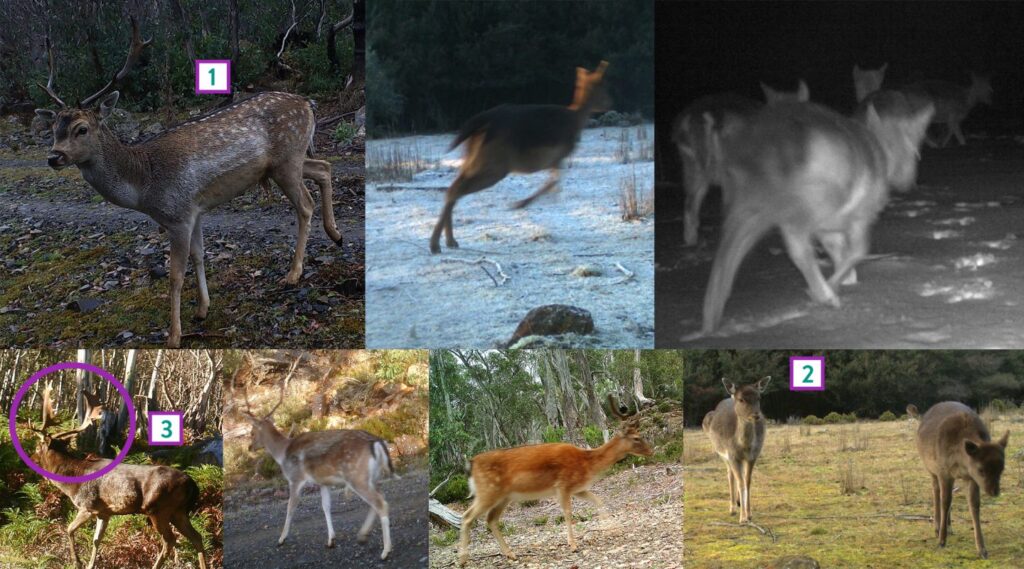
Key identifying features
Medium-sized deer species often recorded in groups. Bucks (males, 1) are much larger than does (females, 2). Coat colour varies considerably. Individuals are most commonly fawn (light brown) coloured with white spots but may be red, dark-brown, black, or even completely white. The rump typically has a white heart shaped marking with black horseshoe outline. The tail is black on top and white beneath. Mature males have antlers that are flattened and palmate at their end, meaning that the angles between the main stem and tines are partly filled in, forming a broad blade with a variable number of points (3). Young males only develop spike antlers. Females do not have antlers.
Similar species
None. The only deer species in Tasmania.
EUROPEAN RABBIT
Oryctolagus cuniculus
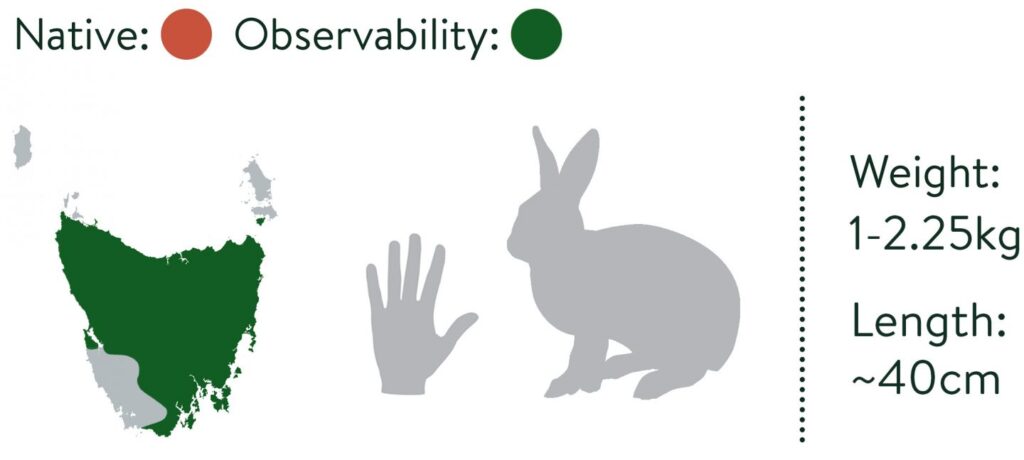
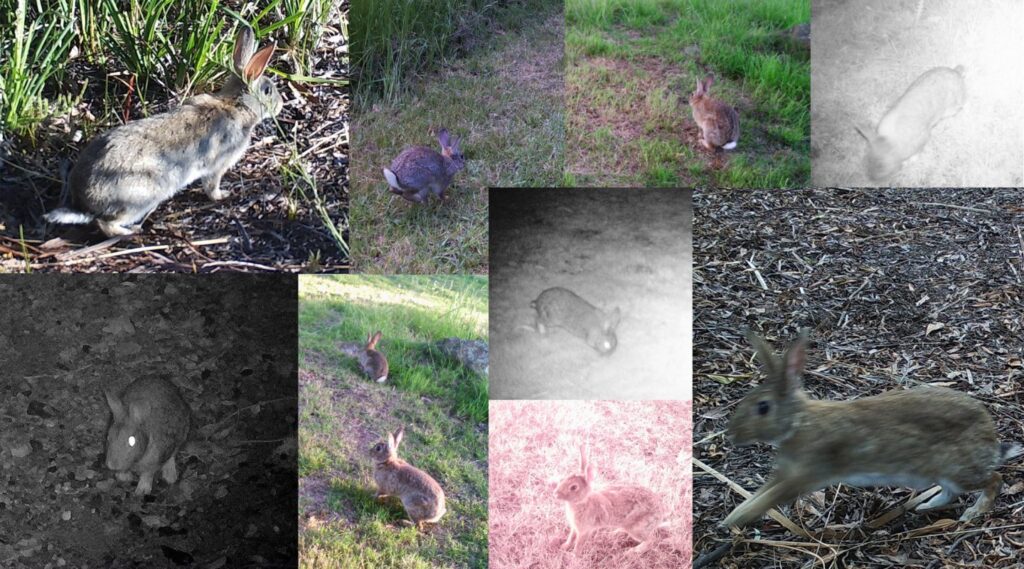
Key identifying features
Long hind limbs with small front limbs. Bulging eyes. Ears are large and long, but no longer than the length of the head. Coat is typically grey-brown with a pale underbelly but black, ginger and white coloured rabbits also occur in the wild. Tail is white underneath and held upwards while running. Shelters in burrows.
Similar species
European hare – Larger body size; much longer hind legs; longer ears with black tips; tail positioned downward when running with black stripe visible.
EUROPEAN HARE
Lepus europaeus
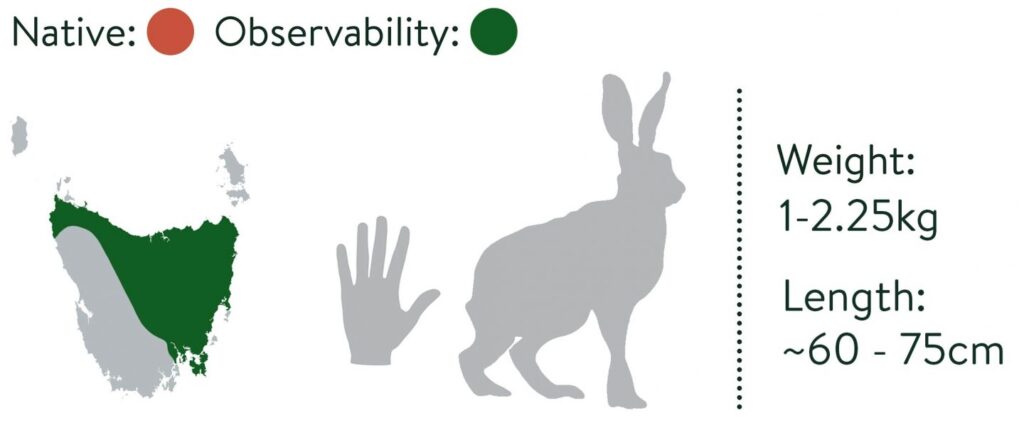
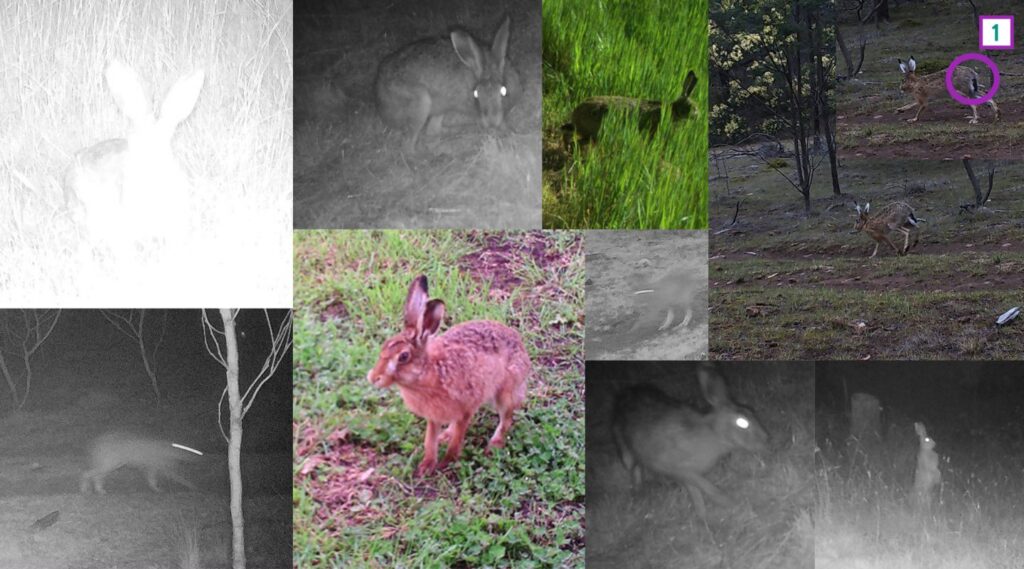
Key identifying features
Can be very large, with females larger than males. Very long hind legs. Ears are longer than head length and have black tips. Coat is yellow-brown often with grizzled black markings and white underbelly. Tail is black on top and white underneath. While running, tail is held downward (black side visible, 1). Eyes are bulging. May be seen standing upright. Do not dig burrows.
Similar species
European rabbit – Much smaller body size; shorter ears; absence of black ear tips and black on the tail; white tail flashes when moving.
ANIMAL TRACKS
What would WildTracker be without some tracks?! Below are examples of footprints made by some of our native fauna. For prints represented at a 1:1 scale, download the pdf here.
